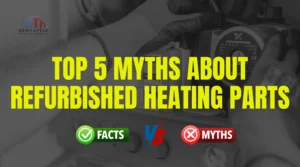How to Repressurise a Potterton Boiler: A Step-by-Step Guide
If your Potterton boiler isn’t working properly, the pressure may have dropped below the safe range of 1 to 1.5 bar. This can cause the boiler to shut down and leave you without heating or hot water. The good news is that you can usually fix this quickly by learning how to repressurise a Potterton boiler using the filling loop.
Follow the steps below to safely bring your boiler pressure back to normal.

Table of contents
Step-by-Step Instructions to Repressurise a Potterton Boiler
Time needed: 5 minutes
Follow the below steps to represssurise a potterton boiler
- Turn Off the Boiler
Start by switching off the boiler completely. Use the fused spur switch, which looks like a large light switch near the boiler. If you cannot find that, turn off the boiler at the main fuse box. Let the boiler cool down fully before continuing.
- Find the Filling Loop
Look underneath the boiler, usually on the right-hand side. You will see the filling loop, which is used to add water to the system. Some boilers have an external silver hose that you attach yourself. Others use an internal filling loop built into the boiler, controlled with a lever or key.
- Connect the Filling Loop (For External Loops)
If your system uses an external loop, make sure both blue taps are turned off. Remove any caps and connect the hose securely between the two valves. Hand-tighten the connections but do not use tools or overtighten.
- Let Water into the System
Turn on the first tap that connects to the cold-water supply. Slowly turn the second tap and listen as water starts entering the system. Watch the pressure gauge closely. When the pressure reaches between 1 and 1.5 bar, turn both taps off and remove the hose carefully. Use a towel to catch any drips. Your boiler is now repressurised and ready to start working again.
Your boiler is now repressurised and ready to go!
Common Reasons for Pressure Loss
If you find that you need to repressurise your Potterton boiler often, there may be an underlying issue. Below are some of the most likely causes.
1. Air Released While Bleeding Radiators
Bleeding your radiators releases trapped air, but it also allows water to escape. This reduces pressure in the boiler. Always check the pressure after bleeding and top up if needed.
2. Leaks in the Heating System
Even small leaks in your pipework or radiators can cause slow drops in pressure. You might not see obvious drips, but damp spots, rust stains, or a slow drop on the pressure gauge can be signs of hidden leaks.
3. Faulty Pressure Relief Valve
The pressure relief valve is designed to protect your boiler from overpressure. If it’s faulty, it may release water even when pressure is within a safe range. This can cause the system to lose pressure over time.
4. Damaged Expansion Vessel
The expansion vessel balances pressure when water heats and expands. If it fails, the system can’t regulate changes, which often results in repeated pressure loss after every cycle.
When to Call a Gas Safe Engineer
You should call a Gas Safe registered engineer if the boiler keeps losing pressure, even after you repressurise it. Also get help if you see leaks near the boiler, spot the E119 fault code, or if the boiler fails to reset. If the pressure relief valve or expansion vessel is suspected to be faulty, these are not repairs you should attempt yourself.
Final Thoughts
Knowing how to repressurise a Potterton boiler is a simple but essential part of boiler maintenance. It only takes a few minutes and can restore your heating and hot water without needing a professional visit. If you find yourself topping up the pressure regularly, it’s a sign that something more serious may be going on. Always call an expert if you feel unsure or the problem keeps returning.
Frequently Asked Questions
This usually happens after bleeding radiators or from small leaks in the system. The E119 fault code confirms pressure has dropped too low.
Yes, as long as you follow the correct steps. Make sure the boiler is off and cool, and always watch the gauge to avoid overfilling.
Reconnect the filling loop, slowly open both valves, and stop once the gauge reaches 1.5 bar. Then close the taps and remove the hose.
If pressure doesn’t rise or drops again quickly, stop immediately and contact a Gas Safe engineer. There could be a leak or faulty part that needs repair.
Potterton E1 fault code, it usually means the water pressure in the heating system has dropped too low. This is one of the most common issues with Potterton boilers and often develops over time. Know in detail about Potterton E1 fault code.





